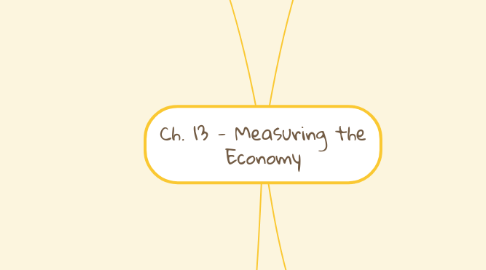
1. 13.4 - What Does the Inflation Rate reveal About an Economy's Health?
1.1. 1.) Knowing the rate of inflation, which is established by the consumer price index, allows economists to calculate the real cost of goods and services in constant dollars.
1.2. 2.) As prices of products go up, wages tend to increase as well.
1.3. 3.) Every year the united states expects inflation to gradually increase.
1.3.1. TERMS
1.3.1.1. Wage-price spiral: an upward trend in wages and prices; an inflationary pattern in which rising prices lead to demands for higher wages, causing producers to raise prices further and workers to demand additional wage hikes.
1.3.1.2. Inflation rate: the percentage increase in the average price level of goods and services from one month or year to the next.
1.4. 4.) Inflation can set off a "feedback loop" caused by increased demand or rising costs. It is done so to keep up with inflation.
2. 13.5 - How Does the Business Cycle Relate to Economic Health?
2.1. 1.) Busness cycles are irregular in both length and severity. Peaks and troughs are difficult to predict, but economists attempt to try to predict it.
2.2. 2.) The business cycle is full of booms and busts. These phases show that the economy is growing and is healthy.
2.3. 3.) Recessions are bound to happen, but if one were to happen for a very long time, this would result in serious damage to the economy which results in a depression.
2.4. 4.) THE BUSINESS CYCLE: the recurring pattern of change as an economy expands and contracts. During expansion, economy activity increases until it can't grow anymore, while during the contraction, economic activity slows until it sinks into a trough and begins to turn around.
2.4.1. PHASES of the BUSINESS CYCLE
2.4.1.1. Expansion: Period of economic growth; increasing real GDP; generally decreasing unemployment rate; generally increasing inflation rate
2.4.1.2. Peak: Highest level of economic activity; real GDP stops increasing; unemployment rate stops increasing; inflation rate stops increasing and may start decreasing.
2.4.1.3. Contraction: Period of economic decline; real GDP decreases; unemployment rate generally increases; inflation rate generally decreases
2.4.1.4. Trough: Lowest level of economic activity; Real GDP stops decreasing; unemployment rate stops increasing; inflation rate stops decreasing and may start increasing
3. 13.2 - How Do Economists Measure the Size of an Economy?
3.1. 1. Growing GDP typically signifies economic health
3.1.1. Gross Domestic Product (GDP) is used to measure a country's total economic output
3.2. 2. To calculate GDP, economists measure expidentures on goods and services produced in a country.
3.2.1. TERMS
3.2.1.1. Intermediate Goods: a good used in the production of a final good; not included in the calculating of GDP
3.2.1.2. Nominal GDP: a measure of a country's economic output (GDP) valued in current dollars; doesn't reflect the effects of inflation
3.2.1.3. Real GDP: measures the output of an economy not in current dollars, but in constant dollars; DOES reflect the effects of inflation
3.3. 3. Economists divide the economy into four sectors: households, businesses, government, and foreign trade.
3.4. 4. Economists use GDP figures to determine not only how big an economy is, but whether it's growing or shrinking and at what rate.
4. 13.3 - What Does the Unemployment Rate Tell Us About an Economy's Health?
4.1. 1.) High unemployment typically signifies a poor economic health
4.2. 2.) Official unemployment doesn't recognize involutary part-time workers. These people can't find full-time jobs so settle for part-time jobs.
4.2.1. TERMS
4.2.1.1. Frictional unemployment: unemployment resulting when workers are seeking their first job or have left one and are seeking another.
4.2.1.2. Structural unemployment: unemployment resulting when the demand for certain skills declines, usually because of changes in technology or increased foreign competition; under such conditions, workers may need retraining to find new jobs.
4.2.1.3. Seasonal Unemployment: results when business shut down or slow down for part of the year; often due to weather.
4.2.1.4. Cyclical Unemployment: results from a period of decline in the business cycle; ;unemployment caused by a contraction.
